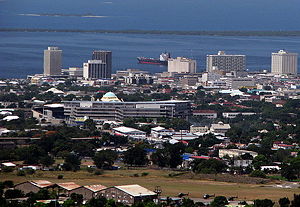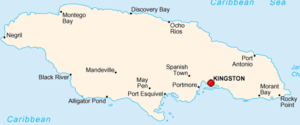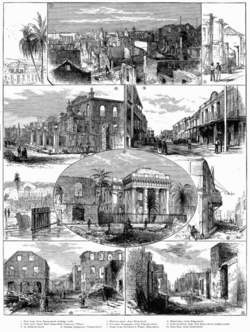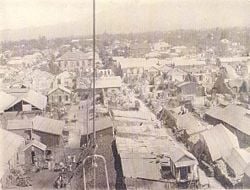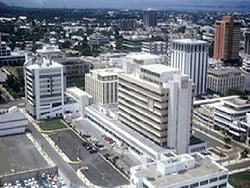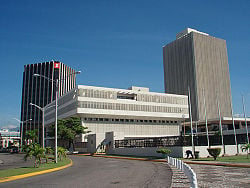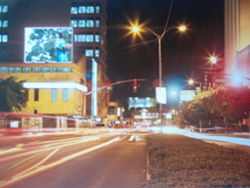Difference between revisions of "Kingston, Jamaica" - New World Encyclopedia
Mike Butler (talk | contribs) |
Mike Butler (talk | contribs) |
||
| Line 75: | Line 75: | ||
By 1716, Kingston became the largest town on Jamaica, and the centre of the island's trade. | By 1716, Kingston became the largest town on Jamaica, and the centre of the island's trade. | ||
| + | |||
| + | The first free school, Wolmer's, was founded in 1729 <ref>[http://www.wolmers.net/boys/history.html Wolmer's Boys School]</ref> and there was a theatre, first one in Harbour St and then moved in 1774 to North Parade. Both are still in existence. | ||
At the time of the American War of Independence (1775-1783) Kingston had a population of 11,000, which was a little under two-thirds of Boston's population of 18,000. | At the time of the American War of Independence (1775-1783) Kingston had a population of 11,000, which was a little under two-thirds of Boston's population of 18,000. | ||
| − | During the Napoleonic wars at the end of the 18th century, Kingston was a prosperous trans-shipment port for goods from England to the Spanish colonies. Britain kept slaves in Kingston until they were sent to Latin America. | + | During the Napoleonic wars at the end of the 18th century, Kingston was a prosperous trans-shipment port for goods from England to the Spanish colonies. Britain kept slaves in Kingston until they were sent to Latin America. |
| + | |||
| + | [[Slavery]] ended in Jamaica on August 1, 1834, with the passing of the [[British Emancipation Act]], which led to emancipation on 1st August 1838 - the date on which former slaves became free to choose their employment and employer. | ||
Jamaica became one of the world's leading sugar exporting nations and produced over 77,000 tons of sugar annually between 1820 and 1824, which was achieved through the massive use of imported African slave labor. The British also brought in Indian and Chinese indentured servants in the early 1800s whose descendants remain today. | Jamaica became one of the world's leading sugar exporting nations and produced over 77,000 tons of sugar annually between 1820 and 1824, which was achieved through the massive use of imported African slave labor. The British also brought in Indian and Chinese indentured servants in the early 1800s whose descendants remain today. | ||
| − | + | In 1862, Kingston became a corporation with a mayor and council with powers to make laws and regulations. A fire that year left a large part of the city in ruins | |
| + | |||
| + | The Morant Bay Rebellion, which broke out on October 11, 1865, after a black man was put on trial and imprisoned for trespassing on a long-abandoned [[plantation]], led to 439 black Jamaicans being killed directly by soldiers, and 354 more being arrested and later executed, some without proper trials. | ||
| + | |||
| + | The rebellion resulted in Jamaica becoming a [[Crown Colony]]. The powers of the Kingston council were transferred to a nominated Municipal Board but by 1885, the affairs of the city were again administered by a mayor. | ||
| + | |||
| + | |||
| − | + | In 1755 the [[List of Governors of Jamaica|governor]] had decided to transfer the government offices from [[Spanish Town]] to Kingston. It was thought by some to be an unsuitable location for the Assembly in close proximity to the moral distractions of Kingston, and the next governor rescinded the Act. However, by 1780 the population of Kingston was 11,000, and the merchants began lobbying for the administrative capital to be transferred from Spanish Town, which was by then eclipsed by the commercial activity in Kingston. | |
At the end of the 18th century, more than 3000 brick buildings were in the city. The harbour fostered trade and naval wars of the 18th century. Kingston took over the functions of Spanish Town (the capital at the time). These functions included, agriculture, commercial, processing, and a main transportation hub to and from Kingston and other sections of the island. | At the end of the 18th century, more than 3000 brick buildings were in the city. The harbour fostered trade and naval wars of the 18th century. Kingston took over the functions of Spanish Town (the capital at the time). These functions included, agriculture, commercial, processing, and a main transportation hub to and from Kingston and other sections of the island. | ||
Revision as of 02:36, 4 January 2009
| City of Kingston | |
| Downtown Kingston and the Port of Kingston | |
| Motto: A city which hath foundations[1] | |
| Location of Kingston shown within Jamaica | |
| Coordinates: 17°59′N 76°48′W | |
|---|---|
| Country | |
| County | Surrey |
| Parish | Kingston St. Andrew |
| Established | 1692 |
| Government | |
| - Mayor | Desmond McKenzie |
| Area | |
| - Total | 480 km² (185.3 sq mi) |
| Elevation | 9 m (30 ft) |
| Population (2001) | |
| - Total | 651,880 |
| - Density | 1,358/km² (3,517.2/sq mi) |
| - Kingston Parish | 96,052 |
| - St. Andrew Parish | 555,828 |
| Time zone | EST (UTC-5) |
Kingston, the capital, the largest city, and chief port, of Jamaica, is located on the southeastern coast of the island country.
Several reggae stars, including Buju Banton, Sean Paul, Bounty Killer, and Beenie Man, hail from Kingston. Attractions include the nearby Hellshire and Lime Cay beaches, the National Gallery of Jamaica, the ruins of Port Royal, and Devon House, a mansion with adjoining park that once belonged to Jamaica's first black millionaire. Several annual and well-visited festivals are held in Kingston.
Geography
Etymology of name – if available.
Kingston sprawls along the southeastern coast of the island, around its fine natural harbour, which is natural harbour protected by the Palisadoes, a long sand spit which connects Port Royal and the Norman Manley International Airport to the rest of the island. The spit has been developed as a recreational and tourist resort.
Kingston is surrounded by the Blue Mountains, Red Hills, and Long Mountain, and is sited on the Liguanea Plain, an alluvial plain located next to the Hope River.
Elevation
Jamaica has a tropical climate with year round constant high temperatures ranging from 86°F (30°C) in January and 91.4°F (33°C) in July. Kingston lies on the dry part of the island, so rainfall is intermittent. When it does rain, showers are short, heavy and followed by sunshine. The rainiest weather occurs in May and June and later in October and November, sometimes extending into December. Tropical storms and hurricanes can occur between July and November. Average annual precipitation is 51.45 inches (1307mm).
Rivers and canals Size – land area, size comparison
Kingston experiences frequent earthquakes, including the 1907 earthquake.
The city proper is bounded by Six Miles to the west, Stony Hill to the north, Papine to the northeast and Harbour View to the east. Communities in rural St. Andrew such as Gordon Town, Mavis Bank, Lawrence Tavern, Mt. Airy and Bull Bay would not be described as being in Kingston.
Two parts make up the central area of Kingston: the historic but troubled Downtown, and New Kingston.
History
The Arawak and Taino indigenous people originating from South America settled Jamaica between 4000 and 1000 B.C.E.[2] Jamaica was claimed for Spain after Christopher Columbus first landed there on May 3, 1494, and adopted the island as his family's private estate. At that time there were over 200 villages ruled by chiefs or caciques, with the south coast of Jamaica being the most populated, especially around what is now known as Old Harbour.[3]
The British Admiral William Penn, father of William Penn of Pennsylvania, and General Venables seized the island for England nearly 200 years later, in 1655.
On July 22, 1692, an earthquake and tidal wave destroyed two-thirds of Port Royal, located at the mouth of the harbour. Survivors fled to the nearby Colonel Barry's Hog Crawle, a place where pigs were kept, and set up a refugee camp on the sea front. About 2000 people died from mosquito borne diseases.
In May 1693 the Assembly declared Kingston a parish. It was not until a fire in 1703 destroyed Port Royal that Kingston began to grow. The town plan done on a grid, was drawn up by John Goffe, a surveyor, and the town boundaries were North, East, West and Harbour Streets.
By 1716, Kingston became the largest town on Jamaica, and the centre of the island's trade.
The first free school, Wolmer's, was founded in 1729 [4] and there was a theatre, first one in Harbour St and then moved in 1774 to North Parade. Both are still in existence.
At the time of the American War of Independence (1775-1783) Kingston had a population of 11,000, which was a little under two-thirds of Boston's population of 18,000.
During the Napoleonic wars at the end of the 18th century, Kingston was a prosperous trans-shipment port for goods from England to the Spanish colonies. Britain kept slaves in Kingston until they were sent to Latin America.
Slavery ended in Jamaica on August 1, 1834, with the passing of the British Emancipation Act, which led to emancipation on 1st August 1838 - the date on which former slaves became free to choose their employment and employer.
Jamaica became one of the world's leading sugar exporting nations and produced over 77,000 tons of sugar annually between 1820 and 1824, which was achieved through the massive use of imported African slave labor. The British also brought in Indian and Chinese indentured servants in the early 1800s whose descendants remain today.
In 1862, Kingston became a corporation with a mayor and council with powers to make laws and regulations. A fire that year left a large part of the city in ruins
The Morant Bay Rebellion, which broke out on October 11, 1865, after a black man was put on trial and imprisoned for trespassing on a long-abandoned plantation, led to 439 black Jamaicans being killed directly by soldiers, and 354 more being arrested and later executed, some without proper trials.
The rebellion resulted in Jamaica becoming a Crown Colony. The powers of the Kingston council were transferred to a nominated Municipal Board but by 1885, the affairs of the city were again administered by a mayor.
In 1755 the governor had decided to transfer the government offices from Spanish Town to Kingston. It was thought by some to be an unsuitable location for the Assembly in close proximity to the moral distractions of Kingston, and the next governor rescinded the Act. However, by 1780 the population of Kingston was 11,000, and the merchants began lobbying for the administrative capital to be transferred from Spanish Town, which was by then eclipsed by the commercial activity in Kingston.
At the end of the 18th century, more than 3000 brick buildings were in the city. The harbour fostered trade and naval wars of the 18th century. Kingston took over the functions of Spanish Town (the capital at the time). These functions included, agriculture, commercial, processing, and a main transportation hub to and from Kingston and other sections of the island.
The government passed an act to transfer the government offices to Kingston from Spanish Town, and in 1872 the capital was transferred from Spanish Town to Kingston. It kept this status when the island was granted independence in 1962.
In 1907, 800 people died in another earthquake known as the 1907 Kingston earthquake, destroying nearly all the historical buildings south of Parade in the city. That was when a restriction of no more than 60 feet (18 m) was instated on buildings in the central business district. These three story high buildings were built with reinforced concrete. Construction on King Street in the city was the first area to breach this building code.
During the 1930s, island wide riots lead to the development of trade unions and political parties to represent workers.
The city became home to the Mona campus of the University of the West Indies founded in 1948 with 24 medical students.
It wasn’t till the 1960s that major change occurred in the redevelopment of Kingston’s central business district. The international attention of reggae music at that time coincided with the expansion and development of 95 acres (380,000 m²) of the Downtown Kingston water front area.
These developments lead to an influx of shops and offices, and the development of a new financial center: New Kingston, which replaced the Knutsford Racetrack. Multi-story buildings and boulevards were placed within that section.
In 1966 Kingston was the host city to the Commonwealth Games.
The westward section of the city was not the focus of development, and that area proved to be a tense area in political times. The 1970s then saw deteriorating economic conditions that led to recurrent violence and a drop off in tourism which later affected the island.
In the 1980 general elections, the democratic socialist People's National Party (PNP) government was outvoted. The subsequent governments have been open market oriented since the 1980s. Within a global urban era, the 1990s saw that Kingston has made efforts to modernize and develop its city structure and functions. Various organizations such as The Kingston Restoration Company, the Urban Development Corporation (UDC) and the Port Authority of Jamaica, along with the Port Royal Development Company, among others sought to develop the urban structure of the city.
Modern development
Today, the city of Kingston sees that the original waterfront area along Harbour Street, once redolent with the aromas of colonial West Indian trade in rums and spices, has been re-developed. Shipping has moved to Newport West, adjacent to the extensive Kingston Industrial Estate.[5]
A great deal of Kingston is pure shanty town, but again one sees striking contrasts, especially in New Kingston, situated between the teeming downtown and mid town areas and the fading but still gracious suburbs of St. Andrew.
The city’s wealthy residents are situated in the suburbs to the north of Kingston, closer to the hills and mountains of the Blue Mountains range. The needs of the wealthy are met by the New Kingston, Manor Park and Barbican / Liguanea areas, and so the downtown is now used mostly by the low-income population. [5]
New Kingston is a business area which embodies the best of modern tropical town planning, graciously combining high rise buildings and well-groomed gardens with the soaring Blue Mountains as a backdrop.
Government
Jamaica is a constitutional parliamentary democracy in which the chief of state is the hereditary English monarch Queen Elizabeth II represented by an appointed governor general. The head of government is the prime minister. After legislative elections, the leader of the majority party or coalition is appointed prime minister by the governor general.
The bicameral parliament consists of the Senate, which is a 21-member body appointed by the governor general on the recommendations of the prime minister and the leader of the opposition, and the House of Representatives, which comprises 60 members who are elected by popular vote to serve five-year terms.
Jamaica is divided into 14 parishes, which are grouped into three historic counties that have no administrative relevance.
The local government bodies of the parishes of Kingston and St. Andrew were amalgamated by the Kingston and St. Andrew Corporation Act of 1923, to form the Kingston and St. Andrew Corporation, or, informally, the City of Kingston. Greater Kingston, or the "Corporate Area" refers to the KSAC; however, it does not solely refer to Kingston Parish, which only consists of the old downtown and Port Royal. Kingston Parish had a population of 96,052, and St. Andrew had a population of 555,828 in 2001.[5]
Economy
The Jamaican economy is heavily dependent on services, which account for more than 60 percent of GDP. The country continues to derive most of its foreign exchange from tourism, remittances, and bauxite/alumina. Remittances account for nearly 20 percent of GDP and are equivalent to tourism revenues.
Jamaica's economy, already saddled with a record of sluggish growth, faces serious long-term problems: high but declining interest rates, increased foreign competition, exchange rate instability, a sizable merchandise trade deficit, plus large-scale unemployment and underemployment.
Jamaica's onerous debt burden - the fourth highest per capita - is the result of government bailouts to ailing sectors of the economy, most notably the financial sector in the mid-to-late 1990s.
Per capita GDP was estimated at $7,400 in 2007.
Kingston, as the capital, is the financial, cultural, economic and industrial centre of Jamaica. Many financial institutions are based in Kingston, and the city boasts the largest number of hospitals, schools, universities and cultural attractions of any urban area on the island. Some notable landmarks in Kingston include, the University of the West Indies, Jamaica Defence Force Museum, Bob Marley Museum and Hellshire Beach
Financial and business services sector Tourism Manufacturing
A government-owned railway ran connecting Kingston to most of Jamaica’s 14 parishes operated until 1992, closed by lack of funding and low use. A few rail lines continue to transport bauxite.
Autobahns radiate from Cologne's ring road.
Kingston is served by Norman Manley International Airport and also by the smaller and primarily domestic Tinson Pen Aerodrome.
The Rhine harbor is one of the larger inland ports in Germany.
Public transport within the city includes buses, a subway system, and the Rheinseilbahn aerial tramway crossing the Rhine. Cologne has pavement-edge cycle lanes linked by cycle priority crossings.
Demographics
Kingston had a population of 651,880 in 2001.
The largest percent of the population is of African heritage. East Indians are the second largest ethnic group, followed by Chinese, European, and Arab (primarily Lebanese). A small number of Hispanics, mostly from Latin America, also reside in the city.
English and English patois, a "broken" or incorrect Standard English, are the spoken languages.
There are a wide variety of Christian churches in the city. Most are Protestant, a legacy of British colonization of the island. The chief denominations are Church of God, Baptist, Anglican, Methodist, Roman Catholic, Seventh-day Adventist, and Pentecostal. Afro-Christian syncretic religions are also widespread.
There is a Jewish synagogue in the city as well as a large number of Buddhists and Muslims.
The University of the West Indies is located at Mona, five miles (eight kilometers) from Kingston’s city centre.
Law
The Jamaica Constabulary Force, Jamaica's police force, is based on Old Hope Road near Liguanea. Smaller police stations, such as Hunt's Bay, Matilda's Corner and Half-Way-Tree, are dispersed across the Corporate Area. The Supreme Court of Jamaica is also located in Kingston. Other courts, such as the Half-Way-Tree Resident Magistrate's Court, Gun Court, Traffic Court and Family Court, make Kingston their home. The Jamaica Defence Force (JDF) has its headquarters at Up Park Camp near New Kingston and Cross Roads. The JDF also operates a major naval base at Port Royal.
Notable residents
Looking to the future
Does the city face no challenges or offer up anything else as a legacy?"
Does the city need reconstruction?
Is it a model city?
Will it run out of water?
Does it have a crucial role to play in the nation?
High unemployment exacerbates the serious crime problem, including gang violence that is fueled by the drug trade. The government faces the difficult prospect of having to achieve fiscal discipline in order to maintain debt payments while simultaneously attacking a serious and growing crime problem that is hampering economic growth.
ReferencesISBN links support NWE through referral fees
- ↑ KSAC lauds contribution of century- old churches downtown
- ↑ http://www.jamaicans.com/articles/primearticles/taino.shtml
- ↑ http://www.jamaicans.com/articles/primearticles/taino.shtml
- ↑ Wolmer's Boys School
- ↑ 5.0 5.1 5.2 Brief history of Kingston, Jamaica Cite error: Invalid
<ref>tag; name "kingston" defined multiple times with different content
Further reading
- Austin-Broos, Diane J. 1984. Urban life in Kingston, Jamaica: the culture and class ideology of two neighborhoods. Caribbean studies, v. 3. New York: Gordon and Breach Science Publishers. OCLC 11105764
- Bolles, Augusta Lynn. 1996. Sister Jamaica: a study of women, work, and households in Kingston. Lanham: University Press of America. ISBN 9780761802112
- Bradley, Lloyd. 2001. This is reggae music: the story of Jamaica's music. New York: Grove Press. ISBN 9780802138286
- Clarke, Colin G. 1975. Kingston, Jamaica: urban development and social change, 1692-1962. American Geographical Society research series, no. 27. Berkeley: University of California Press. ISBN 9780520020252
- Hillman, Richard S., and Thomas J. D'Agostino. 2003. Understanding the contemporary Caribbean. Boulder, Colo: L. Rienner. ISBN 9789766371241
- Sherlock, Philip Manderson, and Hazel Bennett. 1998. The story of the Jamaican people. Kingston, Jamaica: I. Randle Publishers. ISBN 9768100303
- Monteith, Kathleen E. A., and Glen Richards. 2002. Jamaica in slavery and freedom: history, heritage and culture. Kingston, Jamaica: University of the West Indies Press. ISBN 9789766401085
- Wardle, Huon. 2000. An ethnography of cosmopolitanism in Kingston, Jamaica. Lewiston, N.Y.: E. Mellen Press. ISBN 9780889464704
External links
- World Fact Book 2009 Jamaica Retrieved January 3, 2009.
- Encyclopaedia Britannica Kingston, Jamaica Retrieved January 3, 2009.
- Jamaica Library Service History of Kingston Retrieved January 3, 2009.
- Statistical Institute of Jamaica 2001 Census Retrieved January 3, 2009.
- Structure and development of Kingston, Jamaica Retrieved January 3, 2009.
- Jamaica National Heritage Trust Retrieved January 3, 2009.
- The Tramways of Kingston, Jamaica Retrieved January 3, 2009.
- Kingston climate Retrieved January 3, 2009.
Credits
New World Encyclopedia writers and editors rewrote and completed the Wikipedia article in accordance with New World Encyclopedia standards. This article abides by terms of the Creative Commons CC-by-sa 3.0 License (CC-by-sa), which may be used and disseminated with proper attribution. Credit is due under the terms of this license that can reference both the New World Encyclopedia contributors and the selfless volunteer contributors of the Wikimedia Foundation. To cite this article click here for a list of acceptable citing formats.The history of earlier contributions by wikipedians is accessible to researchers here:
The history of this article since it was imported to New World Encyclopedia:
Note: Some restrictions may apply to use of individual images which are separately licensed.
